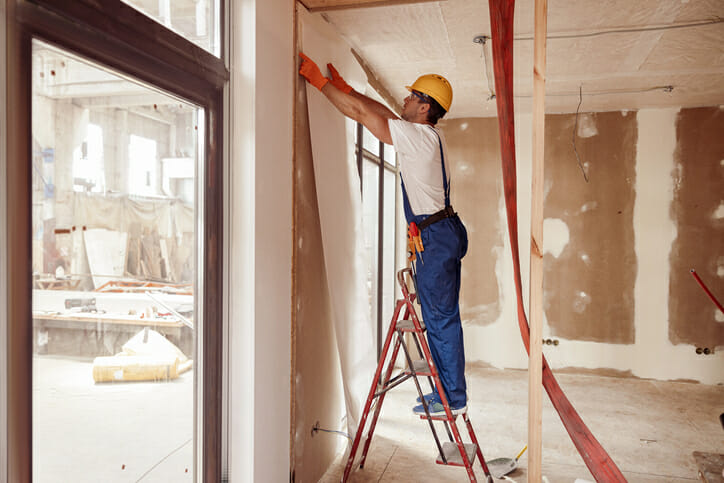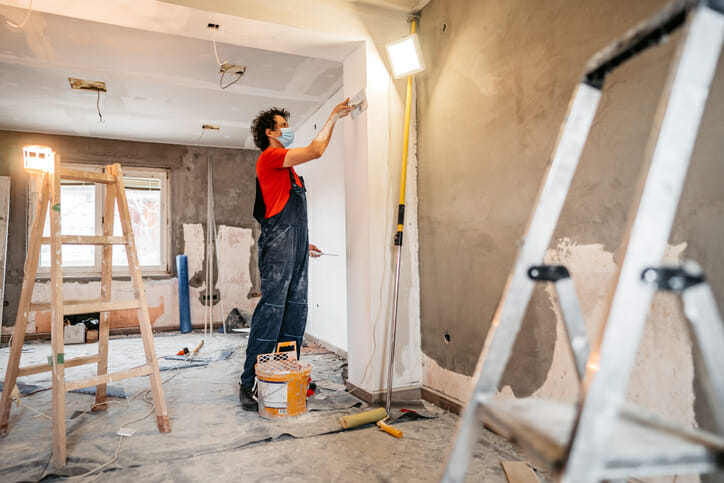If you’d rather build a home than buy one, and plan on borrowing to do so, your lender might steer you toward a construction loan. This would allow you to finance the building of the home; and once it’s complete, you’d take out a traditional mortgage for the property. A construction to permanent loan, on the other hand, allows you to save a step and combine both types of loans into a single borrowing vehicle. Let’s break down how it works.
A financial advisor could help you put a financial plan together for your home buying needs and goals.
What Is a Construction to Permanent Loan?
A construction to permanent loan allows you to finance construction costs and your mortgage together in one loan. This type of loan is sometimes called a single-close loan, as you only have to go through the closing process once versus closing separately on a construction loan and a mortgage.
Typically when building a home, you’d start off with a construction loan. This loan would allow you to purchase the land you want to build the home on if you don’t own a parcel already. You’d also use the proceeds from the construction loan to cover your building costs. Once the home is built, you’d take out a separate mortgage to finance it.
Construction to permanent loans eliminate the need for two different loans. Instead, you get a single loan to purchase the land and build the home that will convert to a permanent mortgage when construction is complete. Loan terms usually range from 15 to 30 years and have fixed interest rates, similar to other types of mortgage loans.
How a Construction to Permanent Loan Works
Construction to permanent loans work by providing you with the funding you need to build the home and mortgage in a single loan package. When you take out a construction to permanent loan, you’re typically only required to make interest payments during the construction process. The interest payment is calculated based on the loan proceeds that have been paid out to your builder to complete work on the home.
During construction, you’ll pay money to the builder for the work that’s been done. Your lender will likely ask for verification that the work has been done before handing over any money from the construction loan proceeds. This may take the form of an in-person inspection of the work.
Once construction is complete, you’ll shift to making principal payments. This only happens once your loan moves from the construction to permanent phase. As with other mortgage loans, you’ll need to make sure the home is properly insured. Depending on where you are building, this might include purchasing flood insurance to supplement your regular homeowners’ insurance.
Construction to Permanent Loan Example

Construction to permanent loans can help to streamline the home-building process. For example, say that you want to buy a lot and build a custom home. You get estimates from several builders to gauge how much it will cost to construct. You then apply for a construction to permanent loan, based on those estimates.
Assuming the loan is approved, you can begin taking draws from the loan proceeds to pay your builders. For example, you might draw $3,000 to clear the land, then $15,000 to cover the cost of setting up the foundation. The lender will inspect the property to verify the work is done and after that, you can move on to the next phase and request another draw.
You do this over and over until the home is built. Once there are no more costs to pay to the builder and the home is ready for you to move in, the construction loan switches to a permanent loan. You’d then make regular payments toward the mortgage, according to the terms set by the lender.
Advantages and Disadvantages of Construction to Permanent Loans
Construction to permanent loans can help you to save time and money during the home construction process. You only have to apply for the loan once, rather than applying for a construction loan and mortgage separately. Instead of having to go through closing twice, you can get a single loan that meets all of your needs.
During the construction phase, you’ll only pay interest toward the loan. Depending on your loan terms, this rate may be fixed, which offers protection against rising interest rates. Once the permanent mortgage phase begins, you’ll have predictability with monthly payments since the loan has a fixed interest rate.
So are there any downsides to choosing a construction to permanent loan? There can be if you’re paying a higher interest rate on average for the combined loan than you would for two individual loans. Construction to permanent loans often have higher rates because they’re riskier for lenders. There may also be a disparity in the rates you pay during the interest-only period and the permanent mortgage period.
You’ll also need to consider down payment requirements for this type of loan. You may need 20% or even more to get approved, which can mean a larger outlay of cash depending on the home’s construction price. There can also be additional hoops to jump through for approval, such as providing the lender with a copy of the building plans and showing documented proof that the builder is licensed and bonded.
Regular inspections could also slow down the build if those take time to complete. And the build can also take longer if an inspection uncovers an issue with the builder’s work.
How to Get a Construction to Permanent Loan

If you’re interested in taking out a construction to permanent loan to build a home, the first step is finding the right lender. This type of loan may be offered by your current bank but you can also look online for other options. Comparing qualification requirements and loan terms can help you narrow down which lender you might want to work with.
Keep in mind that qualification requirements for a construction to permanent loan aren’t necessarily the same as other mortgage loans. For example, there may be requirements for the property itself. You may be limited to building a single-family home that you plan to use as a primary residence, versus a multi-family home, even if you intend to live in one of the units.
You may also need higher credit scores and income or a larger down payment to qualify. As with other types of mortgage loans, the lender will review your credit scores, income, assets and debts. You’ll need to provide a copy of the building plans and your building contract. The land may need to be appraised and of course, you’ll need to have a perc test done to make sure you can build on it.
Bottom Line
Construction to permanent loans can help you to build your dream home without having to take out a second mortgage on the property. There are some pros and cons associated with this type of loan, so it’s important to consider those carefully to decide if it’s right for you.
Mortgage Planning Tips
- A financial advisor could help you decide whether a construction to permanent loan is something that might make sense. If you don’t have a financial advisor yet, finding one doesn’t have to be complicated. SmartAsset’s free tool matches you with up to three financial advisors who serve your area, and you can interview your advisor matches at no cost to decide which one is right for you. If you’re ready to find an advisor who can help you achieve your financial goals, get started now.
- Before taking out a construction to permanent loan or any type of mortgage, it’s important to consider how much home you can afford. Using a home affordability calculator can give you an idea of what’s realistic for your budget, based on your income and how much debt you might already have. Running the numbers can help you avoid ending up with a loan that leaves you house-poor.
Photo credit: ©iStock/urbazon, ©iStock/Pra-chid, ©iStock/dima_sidelnikov
